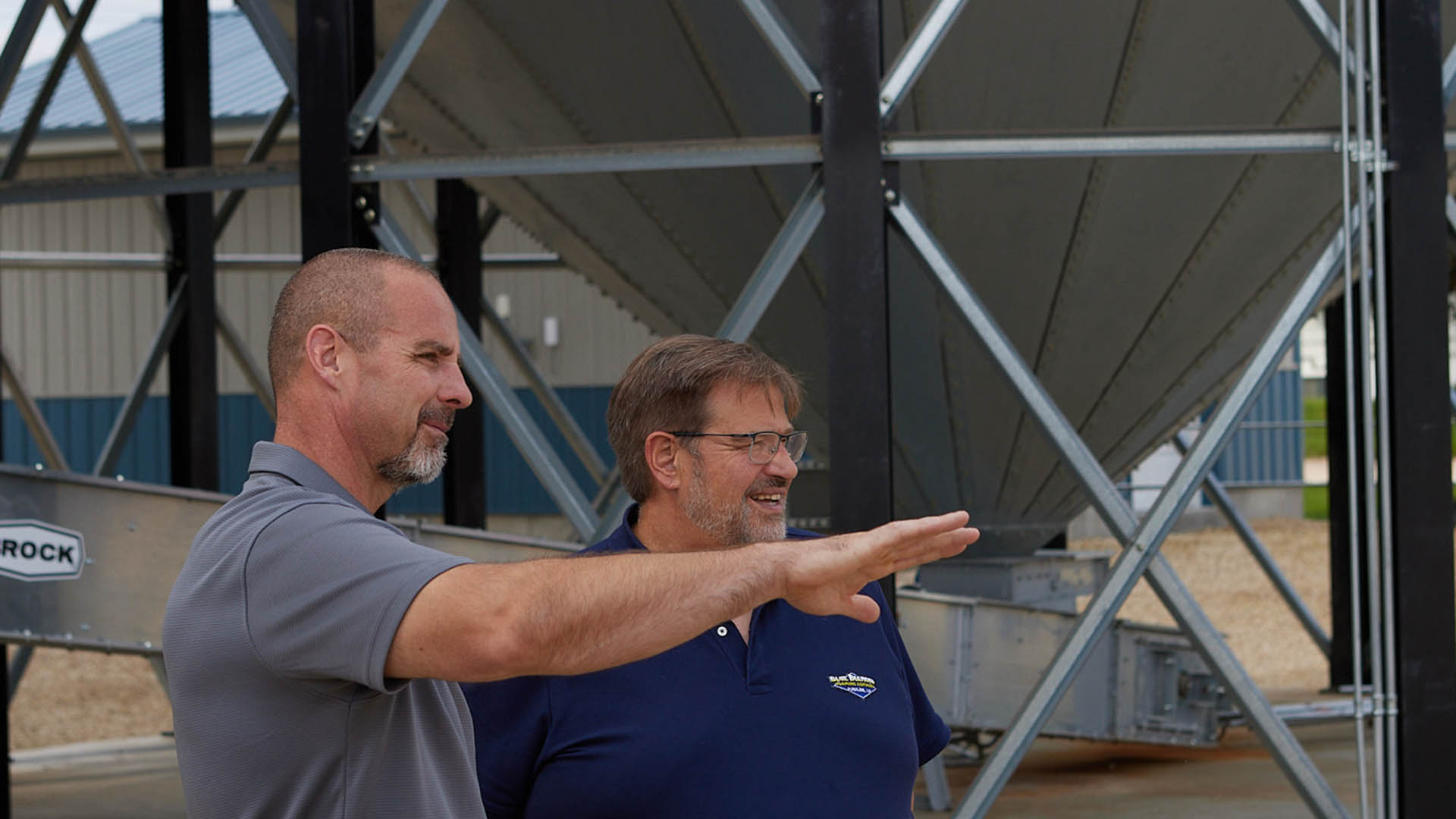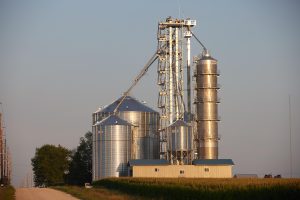Rebuilding a Grain Storage System
When a derecho blew through Marion, Iowa, in 2020 with hurricane force wind, it took down more than trees and roofs. It also leveled the 10-year-old grain bin system at Picket Fence Family Farms just northeast of town.
Partners Ben Riensche, Luke Gosse, R.J. and Cindy Carson, and managing partner Greg Carson immediately went to work on the rebuilding effort for their grain storage and drying system. It created the opportunity to build an entirely new system from the ground up and to learn from past experience.
The first call after the storm.
“When our facilities blew down, I immediately called my millwright, Brian Bartholomew of Bart Brothers Construction out of Dunkerton, Iowa,” said Riensche. We knew exactly how we wanted to rebuild because we had built a similar grain system together on another farm six years prior. Bart Brothers knew all the design criteria, so we had the replacement equipment and bins ordered within days.”

Have good insurance.
After going through this disaster, Riensche encourages every farmer to insure their grain system at replacement cost. “In our case, we were fortunate that Nationwide Insurance was awesome to work with. They declared the grain system a total loss and wrote us a check for replacement value. We rebuilt more than the insurance claim covered because we built bigger and with more capacity.”
Picket Fence utilized the Commodity Credit Corporation’s Grain Facility Loan Program to finance the expanded project.
Clean-slate approach.
Even though the facility was only 10 years old, this storm gave Picket Fence Farms a chance to benefit from hindsight and rebuild bigger, better and faster the second time around.
Two bin foundations were still usable, but all of the steel and equipment had to be replaced. The new system consists of a Brock 60-ft. diameter bin, 36-ft. bin, a 30-ft. hopper, and a Brock commercial tower dryer. It features a dump pit with a Brock conveyor that allows semi-trucks to empty both hoppers at the same time. The grain handling system uses three grain legs fed by Brock conveyors with receiving capacities at 11,000 bushels, the wet leg at 8,500 bushels, and the dry leg at 6,000 bushels per hour.
“We look forward to minimizing labor requirements during harvest because of our faster loading and unloading capabilities, explained Riensche. “We’ve got facilities that we can load out quickly to take advantage of quick-ship bids with better pricing opportunities. We can deliver grain into the Cedar Rapids market and turn this facility over.
“We designed this system with the ability to store grain or blend grain. We look forward to the ability to blend grain so we can fine-tune grain moisture levels or blend out quality issues.
“The extra drying capacity we built into the system will allow our farm to remain competitive, especially when we have a wet corn year like this one. We can also harvest earlier and keep up with the combine.”

Let your millwright or dealer do their job.
According to Riensche, one big sin of many grain system purchasers is to try and design the facility themselves. “You really need to just select a good millwright or dealer, and then let them take the lead. Not that you can’t have preferences, but you need to step aside and let the professional millwright design the facility. That’s all there is to it.
“I tell my millwright, ‘I grow the corn, you build the bins.’ I want to see their best ideas. They know maintenance points our system needs and they know how the equipment goes together.”
Don’t forget reclaim time.
“One thing that my millwright pointed out was the importance of reclaim time,” said Riensche. “Everybody thinks about how long it takes to put grain in a bin. Nobody thinks about all the time they spend taking it out. This system is all automated in our new facility. It reclaims grain and keeps the overhead loadout bin full. We don’t have to pay labor to sit there and watch a bin unload. By automating this process, it leaves us more time to manage our farm.”
Don’t create a bottleneck at harvest.
“If we’ve learned anything it’s that if you only build the minimum dryer, what a bottleneck it can create at harvest,” continued Riensche. “To go from a medium-sized dryer to a big dryer might cost you $100,000 or $200,000. But why would you let that expense stop multiple $700,000 combines and a fleet of semis and employees? I see harvest equipment sitting idle all the time because facilities are choked up on wet corn.
“Why not build enough pre-storage or wet corn storage and why not have enough drying capacity that you never run into this? Our previous tower dryer had a capacity of less than 1,000 bushels an hour. The new one, Brock will rate closer to 3,500 to 4,000 bushels. We’ve at least tripled our drying capacity.
“This will be the sixth Brock dryer I’ve been familiar with in my 45 years of drying corn. Each one is increasingly more efficient and takes less energy to dry a bushel of corn. There’s also a big step in efficiency and reduced energy costs when you go from a horizontal dryer to a tower.”
Prevent phantom yield loss and lodging
Many people believe in what they call phantom yield loss, which is the loss of weight in corn kernels when the crop is dried down naturally in the field. The explanation is that you lose more than just the weight of the water, you also lose some dry matter yield.
When you have dryer capacity to handle wet corn, you can harvest it before losing this yield. You can also start harvest earlier in the fall before you have crop lodging and wind loss.
“We’ve seen it time and time again,” said Riensche. “When we’ve switched to harvest soybeans for a week or 10 days and then come back to corn drying in the field, we’ve noticed 10 or 15 bushels gone from what we were harvesting before. I think this is proof enough for me that phantom yield loss is a real phenomenon. So we can make money harvesting at higher moisture with less in-field loss and less loss of dry matter in the corn from drying artificially versus letting it wait in the field.”
Plant full-season maturities.
A corn plant is a solar collector and a nutrient accumulator. The longer it’s out in the field, the more chance it has to absorb solar radiation and nutrients.
“With all the combine yield monitors and sensory equipment, we’re collecting data all the time on our harvests,” explained Riensche. “We’ve proven again and again that one of the most expensive things you can do is to underplant your maturities on grain.
“We often see farmers switch to shorter-season varieties because they want to avoid a crop drying bill. Well, come to find out the shorter-season varieties also come with a 20 to 25 bushel yield penalty. I can dry corn a long time for that extra 20 bushels. But in order to plant the full maturities, I need adequate drying facilities. That’s why we installed the Brock commercial tower dryer with capacities up to 4,000 bushels per hour.
“This season, we were three weeks behind on planting. But because we have adequate dryer capacity, we didn’t change a thing. We still were able to plant all 108- to 116-day hybrids and take advantage of their potentially higher yields.”

Why the Brock brand.
“When I built my first grain system on another farm, my millwright advocated very strongly that the Brock system would be the best,” said Riensche. “He thought they were designed better, the quality of the manufacturing was better, and that the execution of Brock is unsurpassed. He said you’re going to get what you ordered on the schedule you ordered it. And if there was anything that didn’t square, there would be immediate resolution.
“It was kind of like, ‘you can have any kind of bin you want as long as you order Brock!’ Yes, my millwright would put up another brand of bin if that’s what I wanted, but he thought that the Brock package was superior.
“My first Brock grain facility kicks #&!. It’s interesting, I’ve heard a lot of war stories from everybody who didn’t go with Brock. And I’ve heard zero stories from producers about grain facilities, whatever brand they may be, being better than Brock.”
Historic Site
Picket Fence Family Farms are on the site of the former Lumir Dostal farm northeast of Marion, Iowa. On Oct. 17, 1958, an estimated crowd of 80,000 came to this site to watch the competition in the National Corn Picking Contest and to hear President Dwight Eisenhower and U.S. Senator John F. Kennedy speak.

Kennedy’s speech focused on the interdependence of agriculture and industry. “We in Massachusetts can sell you shirts and fish and washing machines when you have the farm income to pay for them,” he said. “We can prosper in our factories only when you prosper on your farms.”
Eisenhower started his 15-minute speech by saying, “Political speeches won’t pick corn, so I won’t talk long.” He concluded by saying, “I am grateful for the good harvest. I am grateful for the improvement in farm income. Above all, I am grateful that you are still running the farms and haven’t turned the job over to the federal government.”

